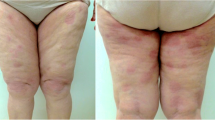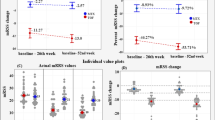Abstract
Mycosis fungoides (MF) is the most common type of cutaneous T cell lymphoma in which the distinction between early stage MF and other inflammatory dermatosis remains difficult. Twenty patients of early stage MF and nine patients with psoriasis and lichen planus were included in this study. Ten MF patients were treated with psoralen plus UVA (PUVA) and the other 10 MF patients were treated with PUVA plus methotrexate (MTX) until complete clinical remission. Synchrotron infrared microspectroscopy (SIRM) found that MF lesions were biochemically different compared to inflammatory diseases. After treating MF with either therapeutic modality, the lymphocytic count decreased significantly in both the epidermis and dermis (P < 0.001) but no biochemical changes were observed in the remaining lymphocytes after treatment, indicating the disease process was slowed by treatment but not eradicated. In conclusion SIRM is a promising method for distinguishing MF from other inflammatory diseases such as psoriasis and lichen planus. A significant reduction in lymphocyte count indicated that PUVA therapy is an effective treatment for early stage MF, and MTX could be reserved for more advanced cases that are not PUVA responsive. However, SIRM evidence of persistent disease suggests that maintenance therapy is recommended after clinical remission.



Similar content being viewed by others
References
Abd-el-Baki J, Demierre MF, Li N et al (2002) Transformation in mycosis fungoides: the role of methotrexate. J Cutan Med Surg 6(2):109–116
Andrus PG (2006) Cancer monitoring by FTIR spectroscopy. Technol Cancer Res Treat 5:2
Benedetti E, Bramanti E, Papineschi F et al (1997) Determination of the relative amount of nucleic acids and proteins in leukemic and normal lymphocytes by means of Fourier transform infrared microspectroscopy. Appl Spectrosc 51:792–797
Clark RA, Shackelton JB, Watanabe R et al (2011) High-scatter T cells: a reliable biomarker for malignant T cells in cutaneous T-cell lymphoma. Blood 117(6):1966–1976
El Bedewi A, El Anany G, El Mofty M et al (2010) The use of synchrotron infrared microspectroscopy in the assessment of cutaneous T-cell lymphoma vs. pityriasis lichenoides chronica. Photodermatol Photoimmunol Photomed 26(2):93–97
Huber MA, Staib G, Pehamberger H et al (2006) Management of refractory early-stage cutaneous T-cell lymphoma. Am J Clin Dermatol 7(3):155–169
Knobler E (2004) Current management strategies for cutaneous T-cell lymphoma. Clin Dermatol 22:197–208
Lin WM, Girardi M (2010) More or less: copy number alterations in mycosis fungoides. J Invest Dermatol 130(4):926–928
Mackie R (1998) Cutaneous lymphomas and lymphocytic infiltrates. In: Fitzpatrick T, Eisen A, Wolff K, Freedberg I, Austen K (eds) Dermatology in general medicine, 4th edn. McGrew Book, New York
Miller LM, Wang Q, Telivala TP et al (2006) Synchrotron-based infrared and X-ray imaging shows focalized accumulation of Cu and Zn co-localized with beta-amyloid deposits in Alzheimer’s disease. J Struct Biol 155(1):30–37
Ortonne N, Buyukbabani N, Delfau-Larue M et al (2003) Value of the CD8–CD3 ratio for the diagnosis of mycosis fungoides. Mod Pathol 16:857–862
Plaza JA, Morrison C, Magro CM (2008) Assessment of TCR-beta clonality in a diverse group of cutaneous T-cell infiltrates. J Cutan Pathol 3:358–365
Salgado R, Servitje O, Gallardo F et al (2010) Oligonucleotide array-CGH identifies genomic subgroups and prognostic markers for tumor stage mycosis fungoides. J Invest Dermatol 130:1126–1135
Trautinger F, Knobler R, Willemze R et al (2006) EORTC consensus recommendations for the treatment of mycosis fungoides/Sézary syndrome. Eur J Cancer 42:1014–1030
Vrettos JS, Meuse CW (2009) Infrared techniques for quantifying protein structural stability. Anal Biochem 390:14–20
Zackheim HS, Kashani-Sabet M, Hwang ST (1996) Low-dose methotrexate to treat erythrodermic cutaneous T-cell lymphoma: results in twenty-nine patients. J Am Acad Dermatol 34(4):626–631
Acknowledgments
Special thanks for the US Department of Energy (DOE) Cooperative Research Program for SESAME for supporting this work.
Author information
Authors and Affiliations
Corresponding author
Rights and permissions
About this article
Cite this article
Bedewi, A.E.L., Youssef, R., Halim, D.M.A. et al. Biochemical Changes Observed After PUVA Versus PUVA Plus Methotrexate Therapy in Mycosis Fungoides Using Synchrotron Infrared Microspectroscopy. Int J Pept Res Ther 19, 209–215 (2013). https://doi.org/10.1007/s10989-012-9336-6
Accepted:
Published:
Issue Date:
DOI: https://doi.org/10.1007/s10989-012-9336-6




